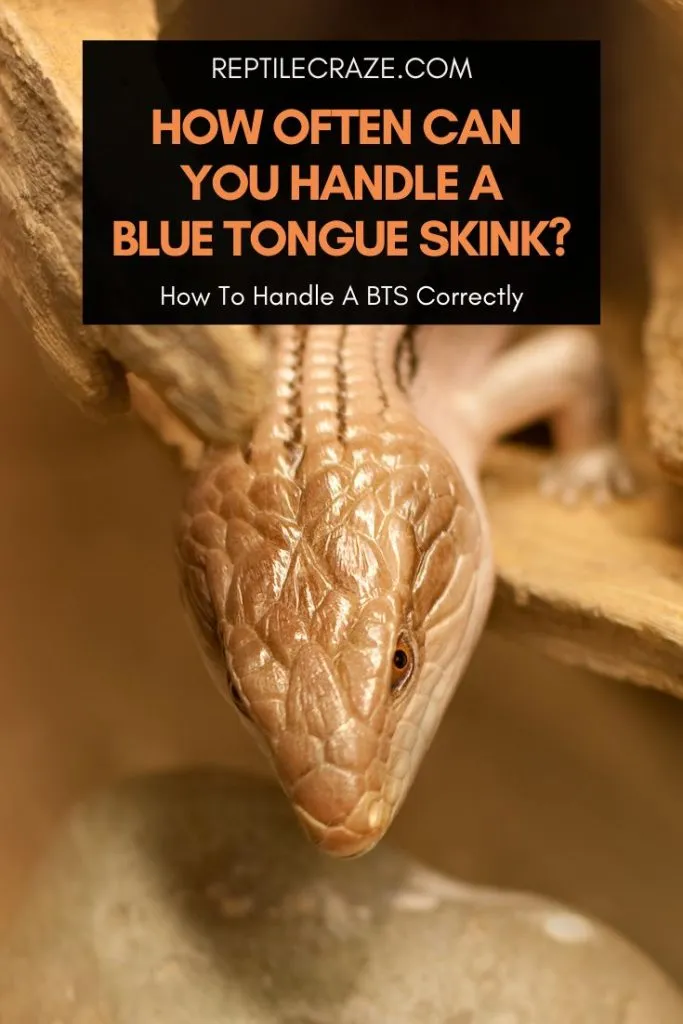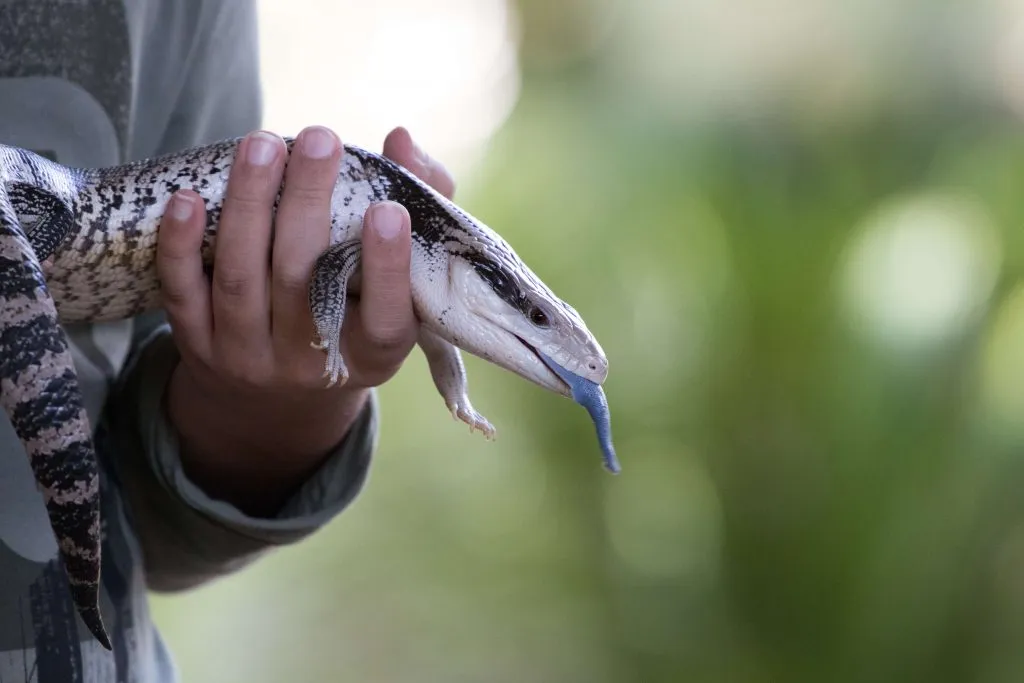
A blue tongue skink is one of the most intelligent reptiles, capable of recognizing faces and voices. Once tamed, this docile and curious pet bonds easily with you and enjoys careful handling. So, how often can you handle your blue tongue skink?
You can handle your blue tongue skink several times a day. Generally, 15 minutes is enough, but some enjoy being held for up to an hour. Start with 5-10 minute sessions, and gradually increase the length of the sessions each week.
In this article, we discuss how to go about handling your BTS. We’ll also discuss why handling is important and when you should leave your blue tongue skink alone.
Table of Contents
Handle Your Blue Tongue Skink Frequently
Once accustomed to handling, most blue tongue skinks enjoy being held. Handling your BTS multiple times a week can keep it happy and friendly.
They can be comfortable being held for long periods, even up to 60 minutes. However, a BTS can’t stay warm for long outside its cage, so it’s a good idea to limit handling time. About ten to fifteen minutes per session is enough.
Importance of Handling a Blue Tongue Skink
Although solitary creatures, blue tongue skinks are friendly and bond well with their owners. Frequent handling sessions are essential for bonding with and taming a BTS.
Without handling, a BTS might become hostile, bored, or scared of you and remain untamed. Make sure you are gentle in your handling, and take things slow at first.
How to Handle Your Blue Tongue Skink Correctly
Blue tongue skinks are diurnal, so you can handle them any time of day. Evenings are a good choice, as your skink will be at its calmest at this time.
Don’t surprise your skink or pick it up from behind. Instead, let it see you approaching and lower your hand for it to climb on. Never pick up your skink by its tail, as it may detach.
Blue tongue skinks are bulky creatures, so you should support its whole body. The best way is to hold it by the chest while supporting its front and hind legs as the tail rests on your arm.
During the initial handling sessions, hold your skink over your lap, bed, sofa, or close to the floor so that it will be safe if it falls. This will also help your BTS to feel less anxious.
Improper handling can scare your skink, and make it defecate or urinate. Remember that if you always return your skink to its cage when it poops or pees, it might learn that this is a way to end the handling session, and do it more often.
What Could Happen if Your Blue Tongue Skink is Handled Too Often?
Most pet skinks enjoy being handled. Some even love to sit and snuggle on your lap, play around you and submit to touch. However, they all have their own personalities, and your individual skink will have their likes and dislikes.
Like many other reptiles, a blue tongue skink may get stressed. If you’re not sure what a stressed skink looks like, here’s a quick run-down of skink body language:
| Sign | Translation |
| Huffing | Annoyed |
| Puffing and hissing | Aggressive |
| Opening mouth and flicking that blue tongue | Warning to potential predator, ready to attack |
| Tail wagging | Irritated |
If your skink exhibits stressed behavior while you’re handling it, such as flicking its tongue, return it to its enclosure and handle it another day. If your handling often seems to cause stress to your BTS, reduce how long and how often you handle it.
How to Accustom Your Blue Tongue Skink to Handling
When you first start handling a new BTS, they may be skittish and get stressed. Be patient and take your time. Begin by offering treats such as snails and pieces of fruit to create a positive connection with you.
If you spend some time around your BTS without handling it, this will also help it to familiarize itself with your presence at the edge of its territory. Fast movements can frighten your BTS, so always move slowly and approach it from the side.
When is the right time to handle a new Blue Tongue Skink?
Even if a BTS has been bred in captivity and is used to humans, it will take time to adapt to its new environment. You should wait for 2 to 3 weeks before handling a new BTS.
How to Start Handling a Blue Tongue Skink
Once your skink tolerates your presence next to or near their
Place your hand in the cage frequently without picking up your skink. This can help it adapt to your scent and gradually lower resistance.
You can also start handling your young skink at dusk or in dim light to build trust. The low light can make it feel safer and more submissive to sleep. It may even sleep on your hand.
When your skink is content with being touched, give short handling sessions of 5 to 10 minutes for the first few weeks, until it’s comfortable with longer handling.

Training a Young Skink for Handling
Younger skinks may shy away from handling and be more defensive than mature ones. The best approach is to be slow and consistent.
One good tactic is to start by talking to them. Skinks often maintain eye contact. Frequent talks will help them recognize your voice and face.
When to Avoid Handling Your Blue Tongue Skink
Even if your BTS enjoys being handled, it’s best to avoid handling them at certain times.
Around Feeding
Handling a hungry skink may result in bites. Your pet may mistake your fingers for
Like other reptiles, it’s also best to avoid holding your BTS immediately after it has eaten. You should leave it alone for 2-3 hours, depending on the amount of
Shedding and Brumation
Avoid handling your blue tongue skink when it’s shedding, as it can be grumpy at that time. When its skin appears dull and begins to crack, it is best to leave it alone.
This skink can shed up to 10 times during the first year and a few times annually in adulthood.
You should also avoid handling your blue-tongued skink when it’s brumating. Brumation occurs during the cold months, and your skink needs to remain inactive without disturbance.
Not in the Mood
We all have good and bad days, and the same is true of your BTS. If your skink may puff, hiss, and run away to hide when you attempt to handle it, leave it alone and try again later.
If they’re still not wanting their normal level of interaction after a day or two, it might be worth getting a check-up with an experienced reptile vet to make sure they’re not sick.
Final Thoughts
A BTS is a docile and friendly creature that loves handling, making it an excellent pet for new reptile enthusiasts. Each skink has different handling needs, so the number one rule is to take things slowly and adjust to your skink’s individual personality.
- Enchi Ball Python: A Unique and Stunning Morph of Python regius - March 27, 2025
- Emerald Tree Monitor: The Enigmatic Green Guardian of the Rainforest - March 26, 2025
- The Egyptian Cobra (Naja haje): A Fascinating Serpent - March 25, 2025
